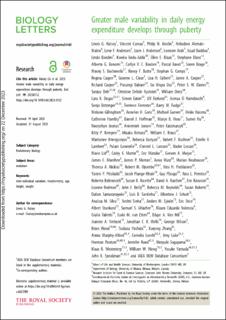Greater male variability in daily energy expenditure develops through puberty
| dc.contributor.author | Halsey, Lewis G. | |
| dc.contributor.author | Careau, Vincent | |
| dc.contributor.author | Ainslie, Philip N. | |
| dc.contributor.author | Alemán-Mateo, Heliodoro | |
| dc.contributor.author | Andersen, Lene Frost | |
| dc.contributor.author | Anderson, Liam J. | |
| dc.contributor.author | Arab, Leonore | |
| dc.contributor.author | Baddou, Issad | |
| dc.contributor.author | Bandini, Linda | |
| dc.contributor.author | Bedu-Addo, Kweku | |
| dc.contributor.author | Blaak, Ellen E. | |
| dc.contributor.author | Blanc, Stephane | |
| dc.contributor.author | Bonomi, Alberto G. | |
| dc.contributor.author | Bouten, Carlijn V. C. | |
| dc.contributor.author | Bovet, Pascal | |
| dc.contributor.author | Brage, Søren Karl | |
| dc.contributor.author | Buchowski, Maciej S. | |
| dc.contributor.author | Butte, Nancy F. | |
| dc.contributor.author | Ekelund, Ulf | |
| dc.contributor.author | Speakman, John R. | |
| dc.date.accessioned | 2024-01-05T09:00:21Z | |
| dc.date.available | 2024-01-05T09:00:21Z | |
| dc.date.created | 2023-10-09T12:43:12Z | |
| dc.date.issued | 2023 | |
| dc.identifier.citation | Biology Letters. 2023, 19(9), Artikkel 20230152. | en_US |
| dc.identifier.issn | 1744-9561 | |
| dc.identifier.uri | https://hdl.handle.net/11250/3110039 | |
| dc.description | Published by the Royal Society under the terms of the Creative Commons Attribution License http://creativecommons.org/licenses/by/4.0/, which permits unrestricted use, provided the original author and source are credited. | en_US |
| dc.description.abstract | There is considerably greater variation in metabolic rates between men than between women, in terms of basal, activity and total (daily) energy expenditure (EE). One possible explanation is that EE is associated with male sexual characteristics (which are known to vary more than other traits) such as musculature and athletic capacity. Such traits might be predicted to be most prominent during periods of adolescence and young adulthood, when sexual behaviour develops and peaks. We tested this hypothesis on a large dataset by comparing the amount of male variation and female variation in total EE, activity EE and basal EE, at different life stages, along with several morphological traits: height, fat free mass and fat mass. Total EE, and to some degree also activity EE, exhibit considerable greater male variation (GMV) in young adults, and then a decrease in the degree of GMV in progressively older individuals. Arguably, basal EE, and also morphometrics, do not exhibit this pattern. These findings suggest that single male sexual characteristics may not exhibit peak GMV in young adulthood, however total and perhaps also activity EE, associated with many morphological and physiological traits combined, do exhibit GMV most prominently during the reproductive life stages. | en_US |
| dc.language.iso | eng | en_US |
| dc.subject | age | en_US |
| dc.subject | evolution | en_US |
| dc.subject | evolutionary biology | en_US |
| dc.subject | height | en_US |
| dc.subject | inter-individual variation | en_US |
| dc.subject | morphometry | en_US |
| dc.subject | weight | en_US |
| dc.title | Greater male variability in daily energy expenditure develops through puberty | en_US |
| dc.type | Peer reviewed | en_US |
| dc.type | Journal article | en_US |
| dc.description.version | publishedVersion | en_US |
| dc.rights.holder | © 2023 The Authors | en_US |
| dc.source.pagenumber | 5 | en_US |
| dc.source.volume | 19 | en_US |
| dc.source.journal | Biology Letters | en_US |
| dc.source.issue | 9 | en_US |
| dc.identifier.doi | 10.1098/rsbl.2023.0152 | |
| dc.identifier.cristin | 2182885 | |
| dc.description.localcode | Institutt for idrettsmedisinske fag / Department of Sports Medicine | en_US |
| dc.source.articlenumber | 20230152 | en_US |
| cristin.ispublished | true | |
| cristin.fulltext | original | |
| cristin.qualitycode | 2 |
Tilhørende fil(er)
Denne innførselen finnes i følgende samling(er)
-
Artikler / Articles [2097]
-
Publikasjoner fra Cristin [1085]

